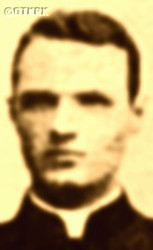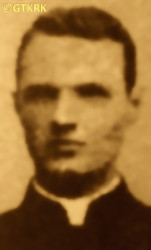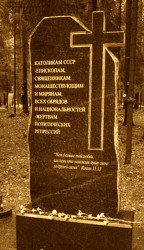Roman Catholic
St Sigismund parish
05-507 Słomczyn
85 Wiślana Str.
Konstancin deanery
Warsaw archdiocese, Poland
full list:
displayClick to display full list

searchClick to search full list by categories
wyświetlKliknij by wyświetlić pełną listę po polsku

szukajKliknij by przeszukać listę wg kategorii po polsku

Martyrology of the clergy — Poland
XX century (1914 – 1989)
personal data
surname
HAŃSKI
forename(s)
Stanislav (pl. Stanisław)
function
diocesan priest
creed
Latin (Roman Catholic) Church RCmore on
en.wikipedia.org
[access: 2014.09.21]
diocese / province
Kamianets diocesemore on
en.wikipedia.org
[access: 2013.05.23]
Lutsk‐Zhytomyr diocese (aeque principaliter)more on
www.catholic-hierarchy.org
[access: 2021.12.19]
date and place
of death
08.12.1937

ITL SvirLagGuLAG slave labour camp network
today: Lodeynoye Polye district, Leningrad oblast, Russia
more on
en.wikipedia.org
[access: 2018.09.02]
en.wikipedia.org
[access: 2023.11.24]
alt. dates and places
of death
Levashovoincl.: Levashovo Wilderness
today: neighborhood in Vyborgsky District in Sankt Peterburg, Saint Petersburg city, Russia
more on
en.wikipedia.org
[access: 2022.06.29]
Sankt Petersburgtoday: Saint Petersburg city, Russia
more on
en.wikipedia.org
[access: 2020.07.31]
details of death
In 1922 arrested a few times for a short time — in relation to the robbery of church property by the Russian Bolshevik authorities.
The last time sentenced to a short term in prison.
Next time arrested by the Russians in 1927 in Derazhnia as part of the attempt to divide church and forced a resolution loyal to the Communist Russian authorities on 10th anniversary of the Bolshevik revolution.
Released on 08.10.1927.
Arrested again on 26.01.1930 in Derazhnia.
Jailed in Kharkiv prison.
On 17.05.1930 sentenced „for spying” for 8 years in Russian slave labour camps (Gulag).
In 1930 jailed in Yaroslav on Volga river prison and next deported to slave labour ITL SLON camp on Solovetsky Islands, where he slaved digging ditches, even during harsh winters, transporting various items 15 km over frozen land and see.
Tortured.
In 1937 moved to a prison cell.
On 25.11.1937 sentenced by the genocidal «NKVD Troika» Russian kangaroo court to death.
Transported out of Solovetsky Islands and prob. brought to ITL SvirLag concentration camp where was executed in a mass murder — possibly n. Alexander Swirsky monastery where Russians exterminated hundreds of Orthodox priests.
alt. details of death
According to some sources murdered in Sankt Petersburg prison or at Levashovskoye Wilderness, where his body was dumped into a mass grave.
cause of death
mass murder
perpetrators
Russians
sites and events
ITL SvirLagClick to display the description, Levashov WildernessClick to display the description, 09.10.1937 judicial murderClick to display the description, 11.08.1937 Russian genocideClick to display the description, Great Purge 1937Click to display the description, Sankt Petersburg (Kresty)Click to display the description, ITL SLONClick to display the description, GulagClick to display the description, Jaroslav on Volga riverClick to display the description, 1839 Kharkiv trialsClick to display the description, Kharkiv (prison)Click to display the description
date and place
of birth
14.12.1880

Berdychivtoday: Berdychiv urban hrom., Berdychiv rai., Zhytomyr obl., Ukraine
more on
en.wikipedia.org
[access: 2021.05.06]
presbyter (holy orders)
ordination
1907

positions held
till 1930
administrator — Derazhniatoday: Derazhnia urban hrom., Proskuriv/Khmelnytskyi rai., Proskuriv/Khmelnytskyi obl., Ukraine
more on
en.wikipedia.org
[access: 2021.09.17] ⋄ St Anne RC parish ⋄ Letychivtoday: Letychiv hrom., Proskuriv/Khmelnytskyi rai., Proskuriv/Khmelnytskyi obl., Ukraine
more on
en.wikipedia.org
[access: 2021.09.17] RC deanery
priest — Zhmerynkaform.: Zmezhynka
today: Zhmerynka urban hrom., Zhmerynka rai., Vinnytsia obl., Ukraine
more on
en.wikipedia.org
[access: 2021.09.17] ⋄ St Alex the Confessor RC parish ⋄ Vinnytsiatoday: Vinnytsia urban hrom., Vinnytsia rai., Vinnytsia obl., Ukraine
more on
en.wikipedia.org
[access: 2021.09.17] RC deanery
administrator — Orynyntoday: Orynyn hrom., Kamyanets‐Podilskyi rai., Proskuriv/Khmelnytskyi obl., Ukraine
more on
uk.wikipedia.org
[access: 2023.03.02] ⋄ Holy Trinity RC parish ⋄ Kamyanets‐Podilskyitoday: Kamyanets‐Podilskyi urban hrom., Kamyanets‐Podilskyi rai., Proskuriv/Khmelnytskyi obl., Ukraine
more on
en.wikipedia.org
[access: 2021.09.17] RC deanery
c. 1917 – c. 1918
administrator — Mikhailpoltoday: Mykhailivka, Rozsosha hrom., Proskuriv/Khmelnytskyi rai., Proskuriv/Khmelnytskyi obl., Ukraine
more on
uk.wikipedia.org
[access: 2023.03.02] ⋄ St Kilian the Martyr RC parish ⋄ Letychivtoday: Letychiv hrom., Proskuriv/Khmelnytskyi rai., Proskuriv/Khmelnytskyi obl., Ukraine
more on
en.wikipedia.org
[access: 2021.09.17] RC deanery
c. 1913 – c. 1916
administrator — Yemilchynetoday: Yemilchyne hrom., Zviahel rai., Zhytomyr obl., Ukraine
more on
en.wikipedia.org
[access: 2021.09.17] ⋄ Our Lady of Perpetual Help RC parish ⋄ Novohrad‐Volynskyitoday: Zviahel, Zviahel urban hrom., Zviahel rai., Zhytomyr obl., Ukraine
more on
en.wikipedia.org
[access: 2020.11.27] RC deanery
c. 1910 – c. 1912
administrator — Oleksandriiatoday: Oleksandriia hrom., Rivne rai., Rivne obl., Ukraine
more on
en.wikipedia.org
[access: 2020.12.11] ⋄ Betrothal of the Mother of God RC parish ⋄ Rivnetoday: Rivne urban hrom., Rivne rai., Rivne obl., Ukraine
more on
en.wikipedia.org
[access: 2021.09.17] RC deanery
till c. 1910
vicar — Chudnivtoday: Chudniv hrom., Zhytomyr rai., Zhytomyr obl., Ukraine
more on
en.wikipedia.org
[access: 2021.09.17] ⋄ Exaltation of the Holy Cross RC parish ⋄ Zhytomyrtoday: Zhytomyr urban hrom., Zhytomyr rai., Zhytomyr obl., Ukraine
more on
en.wikipedia.org
[access: 2021.09.17] RC deanery
till 1907
student — Zhytomyrtoday: Zhytomyr urban hrom., Zhytomyr rai., Zhytomyr obl., Ukraine
more on
en.wikipedia.org
[access: 2021.09.17] ⋄ philosophy and theology, Theological Seminary
others related
in death
MADERAClick to display biography Peter, MIODUSZEWSKIClick to display biography Joseph, OPOLSKIClick to display biography Ignatius, SZYMAŃSKIClick to display biography Vaclav, SZYSZKO–BOHUSZClick to display biography Richard, TUROWSKIClick to display biography Maximilian, WORSŁAWClick to display biography John
sites and events
descriptions
ITL SvirLag: Russian Rus. Исправи́тельно‐Трудово́й Ла́герь (Eng. Corrective Labor Camp) ITL Rus. Свирьский (Eng. Svirskiy) — concentration and slave forced labor camp (within the Gulag complex) — headquartered in Lodeynoye Polye in Sankt Petersburg Oblast. Founded on 17.09.1931, on the basis of subcamps No. 9 and 10 of the ITL SLON concentration camp on the Solovetsky Islands, encompassing former Alexander Svirsky monastery among others. Prisoners slaved at the forest clearing and obtaining firewood destined for Sankt Petersburg, c. 240 km away, in sawmills, wood processing plants, in civil and railway construction, in mica and stone mines, in clay mining, in agricultural work and in the production of consumer goods, etc. At its peak c. 48,000 prisoners were held there: e.g. 47,400 (12.1932); 43,770 (01.01.1934); 40,761 (01.01.1935); 44,273 (01.06.1935); 34,856 (01.01.1936); 22,774 (01.01.1937). Among them were many political and religious prisoners. Many were shot within the camp during the so‐called The Great Purge of 1937‐1938. Formally ceased operations in c. 07.1937. (more on: old.memo.ruClick to attempt to display webpage
[access: 2024.04.08])
Levashov Wilderness: Russian execution site ‐ c. 20 km from Sankt Petersburg. C. 47,000 victims were murdered there in 1937‐1954, including more than 5,000 Poles. In 1937‐1938 Russians murdered more than 100,000 Poles altogether („Polish holocaust”). (more on: www.zplspb.ruClick to attempt to display webpage
[access: 2014.11.14])
09.10.1937 judicial murder: On 09.10.1937 a «NKVD Troika» — a genocidal Russian kangaroo court from Sankt Petersburg consisting of three „summary judges” — sentenced to death, at a single stroke of pen, 1,116 Solovetsky Islands concentration camp’s prisoners. 1,111 names are known — they were murdered in Sandarmokh. The names of the genocidal „judges” are also know. It is also known that on 25.11.1937 similar «NKVD Troika» Russian genocidal kangaroo court sentenced to death few remaining in Solovetsky Islands Catholic priests. All in 12.1937 were transported out towards Sankt Petersburg and murdered prob. in ITL SvirLag camp (or in Sankt Petersburg). (more on: pl.wikipedia.orgClick to attempt to display webpage
[access: 2016.03.14])
11.08.1937 Russian genocide: On 11.08.1937 Russian leader Stalin decided and NKVD head, Nicholas Jeżow, signed a «Polish operation» executive order no 00485. 139,835 Poles living in Russia were thus sentenced summarily to death. According to the records of the „Memorial” International Association for Historical, Educational, Charitable and Defense of Human Rights (Rus. Международное историко‐просветительское, правозащитное и благотворительное общество „Мемориал”), specialising with historical research and promoting knowledge about the victims of Russian repressions — 111,091 were murdered. 28,744 were sentenced to deportation to concentration camps in Gulag. Altogether however more than 100,000 Poles were deported, mainly to Kazakhstan, Siberia, Kharkov and Dniepropetrovsk. According to some historians, the number of victims should be multiplied by at least two, because not only the named persons were murdered, but entire Polish families (the mere suspicion of Polish nationality was sufficient). Taking into account the fact that the given number does not include the genocide in eastern Russia (Siberia), the number of victims may be as high as 500,000 Poles. (more on: en.wikipedia.orgClick to attempt to display webpage
[access: 2016.03.14])
Great Purge 1937: „Great Terror” (also «Great Purge», also called „Yezhovshchyna” after the name of the then head of the NKVD) — a Russian state action of political terror, planned and directed against millions of innocent victims — national minorities, wealthier peasants (kulaks), people considered opponents political, army officers, the greatest intensity of which took place from 09.1936 to 08.1938. It reached its peak starting in the summer of 1937, when Art. 58‐14 of the Penal Code about „counter‐revolutionary sabotage” was passed , which became the basis for the „legalization” of murders, and on 02.07.1937 when the highest authorities of Russia, under the leadership of Joseph Stalin, issued a decree on the initiation of action against the kulaks. Next a number of executive orders of the NKVD followed, including No. 00439 of 25.07.1937, starting the liquidation of 25,000‐42,000 Germans living in Russia (mainly the so‐called Volga Germans); No. 00447 of 30.07.1937, beginning the liquidation of „anti‐Russian elements”, and No. 00485[2] of 11.08.1937, ordering the murder of 139,835 people of Polish nationality (the latter was the largest operation of this type — encompassed 12.5% of all those murdered during the «Great Purge», while Poles constituted 0.4% of the population). In the summer of 1937 Polish Catholic priests held in Solovetsky Islands, Anzer Island and ITL BelbaltLag were locked in prison cells (some in Sankt Petersburg). Next in a few kangaroo, murderous Russian trials (on 09.10.1937, 25.11.1937, among others) run by so‐called «NKVD Troika» all were sentenced to death. They were subsequently executed by a single shot to the back of the head. The murders took place either in Sankt Petersburg prison or directly in places of mass murder, e.g. Sandarmokh or Levashov Wilderness, where their bodies were dumped into the ditches. Other priests were arrested in the places they still ministered in and next murdered in local NKVD headquarters (e.g. in Minsk in Belarus), after equally genocidal trials run by aforementioned «NKVD Troika» kangaroo courts.
Sankt Petersburg (Kresty): Russian prison in Sankt Petersburg where many Polish priests were kept captive. Many of them were also murdered there. (more on: en.wikipedia.orgClick to attempt to display webpage
[access: 2014.12.20])
ITL SLON: Russian Rus. Исправи́тельно‐Трудово́й Ла́герь (Eng. Corrective Labor Camp) ITL Rus. Солове́цкий ла́герь осо́бого назначе́ния Ла́герь (Eng. Solovetsky Special Purpose Camp) SLON — concentration and slave forced labor camp (within what was to become Gulag complex) — headquartered in Solovetsky Islands in Arkhangelsk Oblast. Founded on 13.10.1923 in a famous Orthodox monastery. In the 1920s, one of the first and largest concentration camps in Russia. The place of slave labor of prisoners — at forest felling, sawmills, peat extraction, fishing, loading work on the Murmansk Railway Main Line, in road construction, production of food and consumer goods, at the beginning of the construction of the White Sea ‐ Baltic canal, etc. The concept of the later system of Russian Gulag concentration camps prob. had its origins in the Solovetsky Islands camp — from there the idea spread to the camps in the area covered by the construction of the White Sea ‐ Baltic canal, i.e. ITL BelBaltLag, and from there further, to the entire territory of the Russian state. From the network of camps on the Solovetsky Islands — also called the Solovetsky Islands archipelago — prob. also comes the concept of the „Gulag Archipelago” created by Alexander Solzhenitsyn. It is estimated that tens to hundreds of thousands of prisoners passed through the Solovetsky Islands concentration camps. At its peak, c. 72,000 prisoners were held there: e.g. 14,810 (12.1927); 12,909 (03.1928); 65,000 (1929); 53,123 (01.01.1930); 63,000 (01.06.1930); 71,800 (01.01.1931); 15,130 (1932); 19,287 (1933) — c. 43,000 of whom were murdered, including the years 1937‐1938 when c. 9,500 prisoners were transported from the camp and murdered in several places of mass executions, including Sandarmokh, Krasny Bor and Lodeynoye Polye. Among them were many Catholic and Orthodox priests. After the National Socialist Party came to power in Germany in 1933, a German delegation visited the ITL SLON camp, to „inspect” Russian solutions and adopt them later in German concentration camps. It operated until 04.12.1933, with a break from 16.11.1931 to 01.01.1932, when it was part of and later became a subcamp of the ITL BelBaltLag camp. It operated as such until 1939 (from 1936 as a prison). (more on: old.memo.ruClick to attempt to display webpage
[access: 2024.04.08])
Gulag: The acronym Gulag comes from the Rus. Главное управление исправительно‐трудовых лагерей и колоний (Eng. Main Board of Correctional Labor Camps). The network of Russian concentration camps for slave labor was formally established by the decision of the highest Russian authorities on 27.06.1929. Control was taken over by the OGPU, the predecessor of the genocidal NKVD (from 1934) and the MGB (from 1946). Individual gulags (camps) were often established in remote, sparsely populated areas, where industrial or transport facilities important for the Russian state were built. They were modeled on the first „great construction of communism”, the White Sea‐Baltic Canal (1931‐1932), and Naftali Frenkel, of Jewish origin, is considered the creator of the system of using forced slave labor within the Gulag. He went down in history as the author of the principle „We have to squeeze everything out of the prisoner in the first three months — then nothing is there for us”. He was to be the creator, according to Alexander Solzhenitsyn, of the so‐called „Boiler system”, i.e. the dependence of food rations on working out a certain percentage of the norm. The term ZEK — prisoner — i.e. Rus. заключенный‐каналоармец (Eng. canal soldier) — was coined in the ITL BelBaltLag managed by him, and was adopted to mean a prisoner in Russian slave labor camps. Up to 12 mln prisoners were held in Gulag camps at one time, i.e. c. 5% of Russia's population. In his book „The Gulag Archipelago”, Solzhenitsyn estimated that c. 60 mln people were killed in the Gulag until 1956. Formally dissolved on 20.01.1960. (more on: en.wikipedia.orgClick to attempt to display webpage
[access: 2024.04.08])
Jaroslav on Volga river: Harsh Russian prison for political prisoners — so‐called polit‐isolator — where dozens of catholic priest were held by the Russians, mainly in 1930s, before sending them to Solovetsky Islands concentration camp.
1839 Kharkiv trials: Series of group trials of Polish Catholic priests ministering in Ukraine, by a so‐called «NKVD Troika», a Russian murderous kangaroo court that took place in 1930 in Kharkov (among others on 17.05.1930 and 27‐30.06.1930). Most of the priest were sentences to years of slave labour in concentration camps and subsequently sent first to Yaroslav on Volga river prison and next to Solovetsky Island concentration camp.
Kharkiv (prison): Russian criminal prison where in the 1930s a number of Catholic priests were held prior to being sent to Russian concentration camps.
sources
personal:
katolicy1844.republika.plClick to attempt to display webpage
[access: 2021.12.19], archive.todayClick to attempt to display webpage
[access: 2014.05.09], biographies.library.nd.eduClick to attempt to display webpage
[access: 2014.12.20], www.gulagmuseum.orgClick to attempt to display webpage
[access: 2019.02.02], ru.openlist.wikiClick to attempt to display webpage
[access: 2019.02.02]
bibliographical:
„Fate of the Catholic clergy in USSR 1917‐1939. Martyrology”, Roman Dzwonkowski, SAC, ed. Science Society KUL, 2003, Lublin
„Parish priest of Lutsk–Żhytomyr 1801‐1920 and Kamyanets–Podilskyi 1869‐1919 dioceses”, Fr Waldemar Witold Żurek SDB, Lublin 2023
original images:
www.memo.ruClick to attempt to display webpage
[access: 2016.03.14], www.russiacristiana.orgClick to attempt to display webpage
[access: 2021.12.19], www.gazetapetersburska.orgClick to attempt to display webpage
[access: 2014.05.09], ipn.gov.plClick to attempt to display webpage
[access: 2019.02.02]
LETTER to CUSTODIAN/ADMINISTRATOR
If you have an Email client on your communicator/computer — such as Mozilla Thunderbird, Windows Mail or Microsoft Outlook, described at WikipediaPatrz:
en.wikipedia.org, among others — try the link below, please:
LETTER to CUSTODIAN/ADMINISTRATORClick and try to call your own Email client
If however you do not run such a client or the above link is not active please send an email to the Custodian/Administrator using your account — in your customary email/correspondence engine — at the following address:

giving the following as the subject:
MARTYROLOGY: HAŃSKI Stanislav
To return to the biography press below:
 Click to return to biography
Click to return to biography











